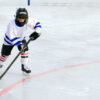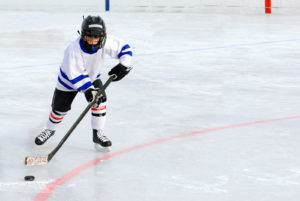
Improved Vision for Hockey Players
Depending on where you live, you may or may not have realized the unprecedented growth of hockey as a youth sport. More and more hockey leagues are popping up all over the country. Many of these kids have big dreams of playing in the NHL. After all, what young player wouldn’t dream of hoisting the Stanley Cup one day? So, how do hockey players’ vision play in to all of this?
For parents who are unfamiliar with the sport, there can be a big learning curve to figuring out all of the hockey terms and understanding the skills good hockey players need to develop. We all know that being a good ice skater is key, but did you know that having good eyesight can also be vital for a hockey player?
 A hockey player does not have to be born with perfect vision; there are ways to improve their vision — without the use of glasses or contacts. Good vision is not only important for good play, but it is important to help keep hockey players safe. If a puck is headed their way, they need to be able to see it and react.
A hockey player does not have to be born with perfect vision; there are ways to improve their vision — without the use of glasses or contacts. Good vision is not only important for good play, but it is important to help keep hockey players safe. If a puck is headed their way, they need to be able to see it and react.
Some of the key vision traits that hockey players need are good tracking, depth perception, peripheral awareness, hand-eye coordination, dynamic acuity and visual reaction time. Players can improve these skills with vision training and proper eye nutrition. Keep reading to learn more about each of these skills and what you (or your child) can do to improve them.
Tracking
Tracking is important because it allows the player to be able to keep the puck in their vision, regardless of where the puck is on the ice. Without knowing where the puck is in play, the player can not be an effective team member. They can also risk injury if the puck is headed their way and they aren’t aware of it. One method to improve tracking is to perform the following exercise: hold your arm out in front of you and, while keeping your head still, follow your finger as you move it back and forth across a 12 to 18 inch area. Tracking exercises are especially helpful for NHL goalies.
Depth Perception
Depth perception allows a hockey player to judge the speed, direction and distance of the puck. This skill is especially important to the goalie. For other players, it is important because it helps the judge the movement of the puck in relationship to the play lines and moving players.
One good exercise you can try out to improve your depth perception is the penny drop. Grab a partner for this exercise and ask them to stand couple of feet in front of you. They should hold a penny between their index finger and thumb over a cup that has been placed on the floor.
They should then move their hand randomly over the cup, sometimes slowly and other times quickly. Your job is to tell them when to drop the penny so that it lands in the cup. This tests your depth perception by assessing where the cup is in relation to the penny.
Peripheral Awareness
Peripheral awareness in hockey is the ability of the player to be aware of the overall action going on while maintaining a more narrow focus. This means a hockey player may be focused on the puck he is moving up the ice, but he is still aware of the players — both offensive and defensive — moving around him. One vision training exercise you can try to improve your peripheral awareness is to play catch with a partner while focusing your vision on something else, such as a tree or building off to the side of your playing field.
Hand-Eye Coordination
Hand-eye coordination is the ability to synchronize the movements your eye is seeing and the movements you need the rest of your body to complete. A lack of hand-eye coordination can cause a player to miss the puck with his stick or keep a goalie from stopping a puck from entering the goal. Hand-eye coordination is essential for almost every sport. You can boost hand-eye coordination with juggling. Yes, this may sound completely silly, but juggling makes your hands and eyes work with each other.
Dynamic Acuity
Dynamic acuity is the ability of the player to track a moving object while in motion. For a hockey player this can mean being able to watch the puck and other players while moving across the ice themselves. Hockey is a fast moving game with players and the puck constantly on the move; if a player does not have good dynamic acuity they will not be able to keep up with the game play.
You can increase dynamic acuity (if you have access to an old record player) by placing letters on the turntable of a record player. You could cut letters out of a newspaper headline or a magazine. Try to identify the letters as they spin around as the record plays. You can increase the difficulty by increasing the speed at which the turntable is spinning.
Visual Reaction Time
The ability of a player to react quickly to what their vision takes in is called visual reaction time. A player who can quickly initiate a physical reaction to what he sees is a better player because he has a better visual reaction time. This skill allows the player to be able to constantly follow the flow of play and, with good instincts, anticipate movements.
A player who wants to improve his visual reaction time can do so while watching television. First, select a sporting event to watch on television. Let’s say you select a hockey game. To improve your visual reaction time, you are going to raise one of your hands every time your chosen team gets the puck. So if you select the team in red, every time a new player in red touches the puck, you will quickly raise your hand.
Hockey is a sport that requires the players to stay focused, and having good vision is a key component of that. The exercises listed above are only a few suggestions. And, don’t forget that an essential part of healthy eyes is a healthy diet. Check out this list of 17 essential herbs, vitamins and minerals that are recommended the optimum vision health.
One last word of advice on becoming a better hockey player: always wear your helmet while on the ice. The helmet not only protects you head, but it protects your eyes. A serious fall on the ice without a helmet can jolt your head hard enough to cause serious internal damage to your eyes. Remember to protect the vision you already have. With good practice, you can improve that vision, too.
Our Rebuild Your Vision Ocu-Plus Formula Contains All 17 Vitamins, Minerals, and Herbal Supplements to Improve Your Eye Health!




Leave Your Reply